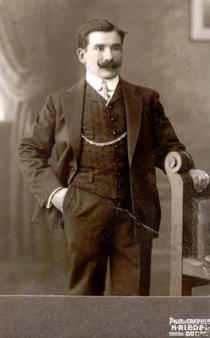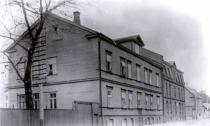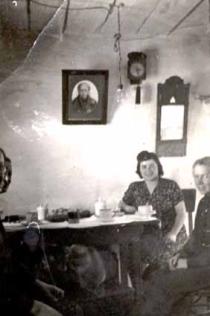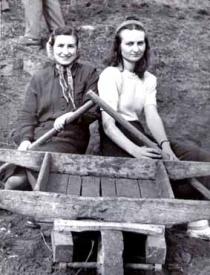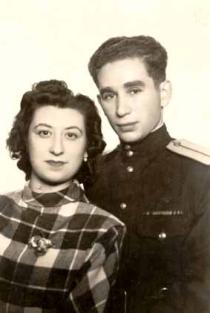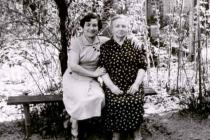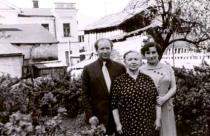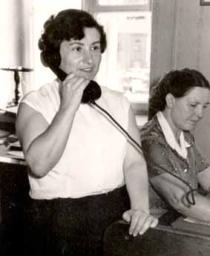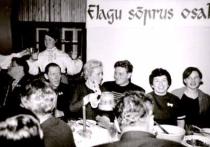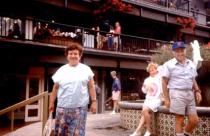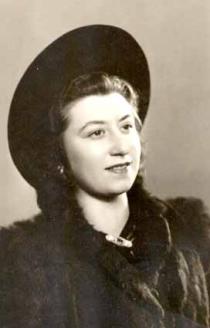
Dora Feiman
Tallinn
Estonia
Interviewer: Ella Levitskaya
Date of interview: June 2005
Dora Feiman lives in a shared one-room apartment [see Communal apartment] 1 in the center of Tallinn. She has a tidy room with potted plants all around. She has many books. There are pictures on the walls. Dora looks young for her age. Her dark hair is nicely done and she has a friendly smile. Dora is an easy-going person and she likes joking and laughing. Her hard life has had no impact on her vivacity and optimism. She always looks at the brighter side of things. Maybe that’s why many of Dora’s friends are younger than her. When talking to her I wasn’t conscious of the age difference. Dora is a very hospitable hostess. Though she has problems with walking having an artificial hip limb, Dora made a delicious cake which she offered me wholeheartedly. She loves having guests. She has no family, but she isn’t lonely. A lot of people are fond of her and find her an interesting person.
Soviet invasion of the Baltics
My family background
Unfortunately, I hardly have any information about my parents’ families. My father’s parents lived in Estonia, but I don’t know where they lived. My grandfather died before I was born and my father’s mother died when my father was just a child. My grandfather remarried. My father told me that my grandfather was a rigorous and austere man. He had a few children in both his marriages, but I didn’t know any of my uncles or aunts. My father, Isaac-Azriel Feiman, was born in 1888. He didn’t enjoy his childhood. He was sent to study a vocation at an early age and started working at the age of 13. My father tanned skins for tanners. Later, he went to work as a supplier for a factory in Tartu [180km from Tallinn]. My father had a religious education. He studied in cheder and could read in Hebrew. His mother tongue was Yiddish.
My mother’s family lived in Zagare [250 km from Vilnius], Lithuania. That was where my mother’s parents came from. Their family name was Sonik, but I don’t know their first names. My grandfather died before I was born and my grandmother died when I was still a child. My grandmother visited us occasionally, but I have vague memories of her. All I remember is that she was short, wore a dark dress and had kind eyes. My grandparents had five children. My grandmother gave birth to more children, but they died in their childhood. I didn’t know two of my mother’s older brothers. They moved to America in the 1900s. My mother corresponded with them until before 1940. They must have been rather well-off. My uncles sent my mother money and supported us. When we returned from evacuation in 1945, they sent us several parcels. I still sleep under the blanket which they had sent in one of their parcels. After my mother’s death this correspondence stopped. We lived in Soviet Estonia, and I was afraid of corresponding with relatives abroad [see Keep in touch with relatives abroad] 2. In the USSR such contacts weren’t safe. One of my mother’s sisters and her family also lived in America. My mother, Ethe, was born in 1893. I don’t know anything about her childhood. She didn’t like to talk about it. My mother’s younger sister stayed in Zagare.
My parents got married in 1913. Their marriage was prearranged as they lived quite a distance from one another. They got married in Zagare and the Zagare rabbi registered their marriage. After they got married my mother moved in with her husband in Tartu. She became a housewife, which was quite common with married women at that time.
My older brother David, the oldest among all children, was born in 1914. In 1916 Abram was born. I was born in 1918, and my Jewish name is Dvora. Later I was addressed as Dora. My younger brother Iosif was born in 1920.
Growing up
At first my parents rented a one-bedroom apartment in the center of the town. When I was born, this lodging became too small for the family, and we moved to a three-bedroom apartment in the same neighborhood. We lived there until the evacuation in 1941. Our family wasn’t very wealthy. We had no property and my father worked for a living. However, my father provided well for the family. My mother could afford to have a housemaid to help her. Also, when the children were small, we had a nanny. I remember my nanny, an old German lady who had a small dog. I remember her taking my older brothers and me for a walk in the suburbs where there were no houses, but fields. Those were memorable adventures for us. After we started going to school, our nanny went to work for another family. The housemaid helped my mother with cleaning the house and washing dishes, while my mother did the cooking. There were no fridges and my mother bought food products at the market and cooked fresh meals every day. She observed the Jewish traditions. She followed the kashrut and cooked traditional Jewish food.
Tartu is the second biggest town in Estonia. It was famous for its university both during the tsarist and Soviet regimes. Young people came from all over Estonia and other countries to study there. There was no Jewish quota in Tartu University. Therefore, during the tsarist regime many Jewish folks from tsarist Russia went to study there due to the existing Jewish quota in the higher educational institutions in their country [see Five percent quota] 3. In 1875 the Jewish Students’ Fund, the first Jewish organization in Estonia, was established. Wealthy Jews could afford to pay for their children’s studies, while the fund supported poor students. That same year the first Jewish elementary school was opened in Estonia. Before 1907, Jewish students worked as volunteer teachers in this school. During the First Estonian Republic 4 the Jewish Cultural Autonomy 5, which granted Jews more rights, was established. There was no anti-Semitism in Estonia. Jews were treated as equal residents.
There was a big Jewish community in Tartu. There were many wealthy Jews who were manufacturers and owners of jewelry, shoe, clothes and food stores. There were many Jewish lawyers, doctors and teachers. They made charity contributions. The community built a home for the elderly and poor people where they were provided with all they needed. There were still many poor people and the community helped them. Poor Jews could get free matzah at the synagogue before a holiday and there were food deliveries so that they could enjoy and celebrate the holidays according to the rites. Anyway, most of the Tartu residents were neither rich, nor poor. They could earn their living and provide for their families, and my father belonged to this very group.
My parents were moderately religious. There were many Jews in Tartu, who went to pray at the synagogue twice a day: morning and evening. We observed Jewish traditions at home. There was a shochet in Tartu. He slaughtered the live chickens which housewives bought at the market. There was kosher meat sold at the Jewish butcher’s. We definitely never had pork at home. We had separate utensils for meat and milk products and my mother watched strictly that nobody mixed one for the other. We also had Pesach dishes stored separately. We only used them on Pesach. On Sabbath my mother lit candles and prayed over them. Then we had a festive family dinner. On the following day my father did no work, but spent his day reading the Torah. He often told Jewish historical tales to me and my younger brother. My mother also tried to do no housework on Saturday. She did the cooking the day before. Our Estonian neighbor came to turn on the light or start the stove on Saturday. However, my parents didn’t go to the synagogue on Saturday. They dressed up and went to the synagogue on Jewish holidays.
I remember Pesach of all holidays. There was a Jewish bakery in Tartu. It baked matzah for Pesach. We always bought sufficient matzah to last through the holiday since we didn’t eat bread on those days. There were sweet desserts made from matzah flour. My parents made wine for Pesach from raisins. My mother made a big bottle of wine each year. When the wine was ready she poured it in smaller bottles and kept them separately from the other food products. It was delicious wine. My mother also made some hop plant drink. She boiled it in a big casserole, had it infused and poured it into bottles. This drink was effervescent like champagne. Of course, my mother made gefilte fish, chicken broth and tsimes 6: traditional Jewish food. She also cooked radish in honey, ground them and topped them with crumbled walnuts. I’m not sure about the details since I’ve never cooked this. All I remember is that while the radish was boiling, it smelled awful, but the dish was very delicious. My mother also made kharoyshes, ground apples with honey and cinnamon.
There were fancy wine glasses placed on the table, and the biggest glass for Elijah the Prophet, filled with wine, was in the center of the table. There was also a set of ten traditional Pesach food products: a piece of bone meat, a hard-boiled egg, bitter greens, a saucer with salty water, etc., according to the rites. There were two seder ceremonies conducted on the first and second Pesach nights. My father wore white clothes and conducted the seder while reclining on cushions. We sat at the table and my father recited the Haggadah. He cut a piece of matzah into three and put one piece under a cushion. One of the children was to find this piece, the afikoman, and put it away to give it back to my father for a ransom. Of course, we also celebrated other holidays: Rosh Hashanah, Yom Kippur, Chanukkah and Purim. On Yom Kippur all the adults fasted for 24 hours. We spent a whole day at the synagogue and had dinner after we went back home in the evening. There was a big and beautiful synagogue in Tartu. Women were on the upper tier and men were downstairs. Many young people visited the synagogue. I also went to the synagogue with my parents.
We spoke Yiddish at home and with other Jews. We spoke Estonian to Estonians. Before our evacuation I didn’t know a single Russian word.
All Jewish children went to the Jewish school. At the time when David and Abram were at school, this was a Jewish gymnasium. After finishing the gymnasium they entered Tartu University. David studied at the Pharmaceutical Faculty, and Abram was a student at the Chemical Faculty. There was a students’ organization in Tartu, and it was called the Jewish Students’ Organization. Other students called its members yiddishists 7. Members of other associations didn’t approve of yiddishists. They believed that Jews were to adapt to the country they lived in rather than move to Israel. Of course, Zionists protested against it.
I also went to the gymnasium. Later, it became a six-year Jewish school. After finishing the sixth grade, I went to the seventh grade in the Estonian gymnasium for girls, who mostly came from wealthy families. This was the best gymnasium in Tartu. The daughter of our landlord taught English over there. She convinced my parents to send me there. I was to study in the gymnasium for six years. My father had to pay for my education there twice a year and also, he bought my school uniform for me. He also had to pay for my younger brother’s studies.
There were two Jewish organizations for young people: Hashomer Hatzair 8 and Betar 9. I was a member of Betar. The Trumpeldor [Betar] members were prepared for their future life in Israel. We were trained to be patriots of Israel. We had frequent gatherings. We were trained in vocations required for future settlers in Israel. We had lectures on Jewish history and were told about the life of Jews in Palestine. It was always interesting in Betar and we gladly attended it. There were also sport sections. I did swimming, gymnastics and skiing. There was Maccabi [see Maccabi World Union] 10, another Jewish organization for young people, and David was a member of this organization. He occasionally joined other students to take a day trip to Tallinn. There were good sporting activities, a gym and trainers, in Maccabi.
There were many Jewish students in the Estonian gymnasium. After the Jewish gymnasium was closed many Jewish girls went to study at the Estonian gymnasium. The teachers and students had a friendly attitude toward us. I never once faced a single demonstration of anti-Semitism in all the years of my studies.
By the time I was to finish the gymnasium my father was severely ill. My older brothers were still in university and the family had to pay for their education, while I had to work to support the family. Before my father fell ill he worked at the tannery, owned by a Jew called Uzhvanskiy. I went to work as an apprentice accountant at the factory and later became an accountant. After finishing the gymnasium my younger brother also went to work. My brother and I were hoping that when our older brothers graduated from university and went to work we would be able to continue our education, but we were disappointed.
We knew that the fascists came to power in Germany in 1933. We knew that Hitler initiated the persecution of Jews. They were persecuted and dispossessed of their property. However, it was only after World War II, when we got to know that there were concentration camps where Jews were exterminated.
In 1939, after Hitler’s effort to invade Poland [see Invasion of Poland] 11 failed, the USSR and Germany signed the Molotov-Ribbentrop Pact 12. According to this pact, Estonia was to be under the influence of the USSR, referring to the complicated international situation which started the establishment of military bases in Estonia [see Estonia in 1939-1940] 13. Tartu was turned into a military settlers’ town. The military lived separately and hardly ever socialized with the locals. I was surprised that there were many Jewish soldiers and particularly, Jewish officers. A military career was closed for Jews in Estonia. Though there were no limitations for Jews in higher educational institutions, no Jews were admitted to military institutions. I remember that when the Soviet military settled down in Tartu, they started buying everything in the stores. We couldn’t even imagine how limited the assortment of goods in the USSR was, and that there were cards [see Card system] 14 for food products. We couldn’t understand this. I remember that Swiss watches were popular with the Soviet military, and they were buying numbers of them. It was hard to understand why one person needed so many watches.
Soviet invasion of the Baltics
In 1940 rallies of workers began. They demanded work. They were organized by the Communist Party of Estonia. It was underground before 1939. The marchers went in columns and were accompanied by Soviet tanks. The government resigned after another wave of rallies. The new government dismissed the parliament and announced pre-term elections. Immediately after elections the new parliament addressed the USSR with the request to annex Estonia to the USSR. On 6thAugust 1940 Estonia became a Soviet Republic.
The factory where I worked was nationalized. The owner was dismissed. At first they appointed a commissar [see Political officer] 15 to supervise the work until a new director was appointed. I remember the day when the Soviet forces entered the town. The director told us to leave work and go to the main square in Tartu. I also joined the rest. Soviet tank forces were entering the town. There were no protests or resistance. People knew that what was happening was inevitable, since the USSR was far too powerful. I didn’t care about policy and accepted the on-going events as a matter of fact. We hardly had any information about the USSR. Whatever little we knew was from the Soviet mass media calling the USSR the country of full democracy and equal rights for all people. We believed that there was no anti-Semitism, unemployment or political repressions in the Soviet Union and that all people enjoyed equal rights.
Our family had no property and therefore, we didn’t loose anything. Of course, those whose property was nationalized by the new regime weren’t happy about it, but they didn’t dare to illustrate their unhappiness. Newcomers from the USSR were by no means shy and felt quite at home.
Gradually food products and other commodities were disappearing from the stores. Estonia had never known lines in stores before. There were lines for butter, fish, sausages, socks and handkerchiefs. The Soviet currency was introduced. It became next to impossible to buy any imported or even local goods.
Some of the girls I knew started seeing Soviet military men and even married them. Our family had no contact with the Soviet newcomers. At work I mostly socialized with Jews and Estonians and our family acquaintances were mostly Jewish.
14thJune 1941 was a terrible day in the history of Estonia. On this day, Soviet authorities deported Estonian residents [see Soviet Deportation of Estonian Civilians] 16. Our family avoided this horror. We weren’t wealthy and had no property or business of our own. However, we knew many people who were forced to leave their homes. An NKVD 17 truck arrived at their homes; they were given little time to pack their belongings and were taken to the railway station where trains were waiting to take them away. This action was well-organized. Many families were deported from Tartu. There were Jewish and Estonian deportees. It wasn’t their nationality that mattered, but their state of wealth and political views. This was a scary situation. I remember going to work one morning, when I heard that a few employees of the factory had been sent to exile. Everything was done in secret to prevent people from hiding away.
During the war
On Sunday 22ndJune 1941, one week after the deportation, we heard that Hitler’s armies had attacked the Soviet Union without declaring war [see Great Patriotic War] 18. Molotov 19 announced on the radio that the war with Germany had begun, and that the Soviet Union would win. There were battles somewhere not too far away, and the following day we could already hear the artillery cannonade.
Evacuation was prompt in Estonia. My parents didn’t consider evacuating. My father kept saying that we did no harm to anyone and that the Germans weren’t going to do anything evil. Most people thought Hitler wasn’t as bad as the Soviet propaganda had described him. Also, the deportation played a major role in people’s unwillingness to evacuate. They feared the Soviets more than the fascists and even more so, they waited for the Germans as their rescuers.
Iosif was recruited to the army in the first days of the war. My other brothers stayed at home. On the morning of 5thJuly 1941, a boy brought us a note from my parents’ friends. They wrote that they were at the railway station and were on the last train to the rear of Russia, and that if we wanted to escape death we had to pack immediately and go to the station. We didn’t have time to pack or consider. We packed whatever was at hand. We hoped that the war wasn’t going to last long. We were sure that we would be home before winter and took no warm clothes with us. The railway station was crowded. There was a cattle freight train and we squeezed into a carriage. It was awful there. There were small windows high by the ceiling, and there were two-tier plank beds along the walls. The carriage was packed with people who were sitting on their bags and suitcases. Many of our acquaintances stayed in Tartu. They were hoping that by knowing German they would manage somehow. None of them survived the German occupation.
All we knew about our point of destination was that it was in Russia. The train was continuously bombed on the way. During the raids by German planes the train stopped. People jumped off and scattered around trying to hide away. I stayed in the train during such air raids. I thought if I was to die it didn’t matter where I was, in the train or in a trench. And, as a matter of fact, no bomb or splinter hit our carriage.
We arrived in Chuvashia [today Russia] and were taken to a kolkhoz 20. We were lodged in a room. Our landlady was a poor farmer. The room was dirty and smelly, and there were bugs. There was no food and we had to trade whatever belongings we had for food. The German forces were in the vicinity of Moscow [today Russia]. They were advancing promptly. We feared that they would soon reach where we were. Life was very hard, particularly because we didn’t know any Russian.
Our acquaintances from Tartu decided to go to Almaty [today Kazakhstan]. They suggested that I go with them. I thought that after I found a job in Almaty I would be able to have the rest of my family join me. In the beginning I had to look for a job where my lack of knowledge of the Russian language was of no importance. I got jobs on farms or worked on road repairs. Gradually I learned to read and write in Russian. My neighbor was the railway station logistics manager, and his wife, a very kind woman, often helped me in a neighborly way. When I learned enough to talk with her she promised to talk to her husband and ask him whether he would find a job for me. I went to the HR department and the manager interviewed me. She said I had to improve my Russian language skills, but she trusted I might manage as I was. She offered me a position as a file controller in the railway office. I was to enter the information on movements of trains and materials assigned to the department. Of course, this work was difficult for me in the beginning. I had a German-Russian dictionary with me, and it helped me at first.
My co-worker, who had evacuated from Russia, helped me. We shared a room which we rented from a landlady. I’m very grateful to this lady. She taught me how to generate the files and corrected my mistakes. I worked in the logistic department till the end of the war. Of course, I didn’t earn much. We received employee cards for 400 grams of bread per day. My salary was just enough to pay for this ration of bread. There was saw dust in this bread and it was under baked, which made it heavy. It looked more like a piece of clay. My food was bread and water. However strange it may seem I wasn’t slim. I was rather plump. I walked three kilometers to work. It was all right in summer, but in winter each day was painful. I had no winter clothes. My acquaintance gave me an old coat. It wasn’t warm, but it was better than nothing. As for shoes, it was a nightmare. I left home wearing sandals and I wore them all through the first winter. I walked on snow and ice in them. Perhaps, that’s why I have ill legs. The climate in Kazakhstan is better than in Estonia. The air is dry, and the summer heat or winter cold isn’t as unbearable as in Estonia. However, winter temperatures dropped to -30 or -40°C, and I was always freezing.
The following winter I was given a coupon to get felt boots, and my feet were warm in them. When my sandals fell apart, I made cloth shoes with carton soles. Of course, there were clothes and shoes sold at the market, but I couldn’t afford them. What I earned was sufficient enough to pay for this rationed bread, but even this wasn’t always available. Sometimes it was replaced with little flour. Also, we gathered burdock leaves, cut them with a knife, mixed them with flour and baked flat breads on the red hot stove. We had no salt. Occasionally, we traded whatever we had or bread for salt at the market, and at times we just managed without salt. I never had one single bar of soap during the evacuation. It was too expensive at the market. We made a solution with stove char to wash ourselves, clothes and underwear. Of course, not all those in evacuation were as needy as we were. There were families of various bosses in Almaty. They had everything. They were well off even in the evacuation. I met one such family. They were a mother and daughter. They sympathized with me and invited me over for some food. They introduced me to two Estonians living in Almaty. Since then I didn’t feel so awfully lonely.
I corresponded with my mother and brothers. There was no writing paper or envelopes. We wrote letters between the lines on newspaper pieces. Then we folded these sheets in triangles and wrote the address. There were no stamps required. The post office stamped the enveloped with ‘free’ stamps, and these letters reached their addresses. My mother wrote that both my brothers had been recruited to the army. They were in the Estonian Rifle Corps 21 to which my younger brother had already been recruited at the very beginning of the war. My father was severely ill even before the war. The hardships of evacuation were too much for him. He died in 1943. My mother was there all alone. She couldn’t move in with me. It was too complicated and so we lived apart throughout the wartime. My brothers also wrote to me from the front line. It was amazing that despite all this mess in the country the mailing system worked without fail.
In late 1944 we heard that Estonia had been liberated from the fascists. Our spirits changed. We knew that the end of the war was close. On 9thMay 1945 Germany capitulated. This was a holiday for all. People rejoiced in the streets dancing and singing. I was eager to go back home, but to return to Tartu I needed a letter of invitation. My mother returned home, and my management wanted me to stay at work. They said that they had no replacement and tried to convince me to settle down in Almaty. My brother David sent me an invitation letter, but it was only after a few months that I managed to leave for home.
After the war
When my mother returned to Tartu, she found other tenants in the apartment where we had lived before the war. Our belongings were gone. My mother lived in a smaller apartment in the same building where we had lived before the war. This was the very apartment she had lived in after her marriage. I lived with her. David married Sheina, a Jewish girl. After the wedding they moved to Tallinn. David worked as a pharmacist in a drugstore. After some time he was promoted as the drugstore manager. They had two daughters: Lea, the older one, born in 1950, and Rachel who was born in 1955. After the war my second brother stayed to serve in Germany. He returned in 1949. Abram married David’s wife’s cousin Sheina. Their only son Hari was born in 1958. Abram worked as a chemical engineer in the laboratory of the Tartu shoe factory. After finishing his service in the army Iosif entered a militia school. Upon graduation he was sent to work in Saaremaa. Iosif married twice. Both his wives were Estonian. His son Victor was from his first wife Ruth and was born in 1950. His second wife Aina gave him two children: daughter Liya, born in 1958, and son Ivar, born in 1960.
All of my mother’s relatives living in Lithuania were killed by the Germans. Only my mother’s sister’s daughter Ida, if my memory doesn’t fail me, survived. She was married and had three children. Her family was in the Vilnius Ghetto 22. The Germans killed her husband and children. Ida was taken to a concentration camp. I don’t know how she managed to survive. When the camp was liberated, she didn’t want to go back to Lithuania where her family had been killed. She went to the USA. On the boat to the USA she met a man. He had lost his wife and children, too. They got married after they arrived in the USA. They corresponded with my mother, but after my mother’s death I didn’t keep in touch with my cousin. During the Soviet regime correspondence with relatives abroad wasn’t safe. Though I was no bigger than a common citizen, I was still afraid of having problems in this regard. I lost contact with my cousin. In the late 1980s my brother wrote to her, but his letter returned with the stamp ‘Undeliverable.’ She might have passed away, being ten years older than me.
We knew that during the occupation, Estonians had helped the Germans identify and exterminate Jews. This was true, but we also knew that this wasn’t just hatred towards Jews that made them do this. If it hadn’t been for the deportation in 1941, and if people hadn’t been so afraid of the Soviet regime, they wouldn’t have waited for the Germans as their rescuers. Many of them were hoping that the Soviet regime would never be reestablished. At least, when we returned to Tartu, Estonians were very sympathetic towards us and tried to help as much as they could.
When I was back in Tartu, I worked at the shoe factory, in the logistics department. I was an accountant and was later promoted as the logistics manager. My Russian language skills helped me with my work. I could also handle Russian documentation. There were few Jews in our department.
In 1948 the campaign against ‘cosmopolitans’23 began in the USSR. Every day newspapers published articles blaming the rootless cosmopolites: scientists, writers and artists. They were full of Jewish surnames. If an artist or a writer had a pseudonym, they were sure to mention his or her original Jewish name. Those convicted of cosmopolitism lost their jobs and were sent to the Gulag 24. Many of them were sentenced to death and executed. The Jewish Anti-Fascist Committee 25 that made a great contribution into the victory over fascism during the war was eliminated. Solomon Mikhoels 26, a famous Jewish actor, perished. The official version stated that he died in a truck accident, but people were saying that it wasn’t an accidental death. These progressions were feeding anti-Semitism. In Estonia, anti-Semitism came about in 1940 after it was annexed to the USSR. In the beginning it existed on a common everyday level and was initiated by newcomers from the USSR, while in 1948 it acquired the state level ascendancy. I didn’t believe that those articles were published with the official authorities being unaware. I didn’t face any anti-Semitism at work. Most of my co-workers were Jewish and Estonian, and they had no friendly feelings toward the Soviet power. However, at the enterprises with Russian management employees faced anti-Semitism and were afraid of losing their jobs.
In 1949 the second deportation of Estonian residents occurred. However, while the first deportation in 1941 involved Estonian residents despite their nationality, the second deportation was focused on Jews. Some people returned to Estonia from exile after the war. The Jews among them were deported again, including women and children. My niece’s mother-in-law Lia, who is living in the USA now, was deported twice, and she was just a child when this happened the first time. Of course, there are few of them living now, only those who were children at that time. This was terrible and one wouldn’t argue with that, but I do think that those who were deported had a chance to survive. Of course, the exile was hard, and the deportees were involved in wood cutting or other hard physical work and they were starving, but at least they weren’t shot at. Many died, but there were survivors as well while Hitler was killing all Jews, and the survivors were few, if any. That made a difference.
Of course, there was much discontent with the Soviet regime, but there were no open protests. The fear of the Soviet regime was very strong. After the Doctors’ Plot 27 initiated in January 1953 the anti-Semitism developed an official nature. There were many Jewish doctors in Estonia, and they were severely affected. I remember people talking at a polyclinic whether they should visit a Jewish doctor or not. It needs to be mentioned here that mostly such talks were heard from newcomers from the USSR, while the locals were quite neutral about it.
After the Twentieth Party Congress 28, where Khrushchev 29 denounced Stalin’s crimes we had big hopes that our lives would change. Of course, there were no mass repressions or exiles, but everything else remained the same. We weren’t allowed to have contact with relatives abroad or observe Jewish traditions and celebrate Jewish holidays openly. Anti-Semitism didn’t disappear from our lives either. We faced it in everyday life and on the official level.
At home we continued to observe Jewish traditions. Of course, we did it quietly and at home. There was no synagogue in Tartu after the war. It burned down during the war, and the local authorities made no effort to restore it afterwards. Abram, who was in Tartu, also observed Jewish traditions. Of course, it was difficult to follow the kashrut. Not only kosher, any other food products were hard to get. I think the card system in the country lasted till the late 1940s. We couldn’t celebrate Sabbath since Saturday was a working day in the USSR. Sunday was the day off. When my mother was alive, Abram and his family joined us on holidays. There were no places selling matzah and so we made it at home. Of course, we followed the rules of making matzah, there was to be a maximum of 18 minutes between making the dough and the actual baking.
We made matzah long before Pesach. Abram’s wife Sheina joined us to make matzah. We had to make sufficient matzah for two families. There was no bread at home during the holiday. We only ate matzah. On the holiday my mother removed all chametz from the house, sweeping away all bread crumbs. Since we had no kosher dishes for a long time, my mother koshered our everyday utensils and dishes till we bought special utensils and dishes for Pesach. It was hard to buy food products for a fancy meal on Pesach in the first postwar years, but my mother managed somehow to buy chicken, fish and all the ingredients to make strudels. We enjoyed these holidays. My brother, his wife and son joined us. Abram conducted the seder according to the rites. On Yom Kippur we fasted and we also celebrated other Jewish holidays. Occasionally, my two other brothers, their wives and children visited us on holidays and this made the holiday twice as enjoyable.
My mother died in 1961. We buried her in the Jewish cemetery in Tartu following the Jewish traditions. The Jewish cemetery wasn’t destroyed during the occupation. Not one grave was touched or a gravestone ruined. It existed through the duration of the Soviet regime, and it’s still there. After my mother’s death we celebrated all the holidays at my brother’s place.
We also celebrated Soviet holidays: 1stMay, 7thNovember [October Revolution Day] 30, and Victory Day 31. Soviet holidays were days off. On the eve of a holiday we had a celebration at work. Soviet parades on Soviet holidays were traditional, so we went to parades, and in the evening we had a party at my home or at one of my colleagues place. We were young and grabbed any occasion to have fun. We didn’t care so much about the subject of the holiday, but just enjoyed getting together to make some nice food, dance and laugh. However, Victory Day was a really great holiday. On that day we celebrated having survived this horrible war which took so many lives, remembered our relatives and dear ones, who had fallen victims to this war. This holiday combined joy and grief.
Another family shared the apartment with us. They were Jews from Tartu: a man, his wife and their son. They had returned from evacuation. Their house had burned down, and they had no place to live. Before I returned, my mother had invited them to stay with her till they found a place to live. I don’t know whether they failed to find a place or they never looked for one, but when I returned to Tartu, they were still living in our apartment. After my mother arrived she received a one-bedroom apartment, but considering the new lodgers, we happened to live in a shared apartment: my mother and I lived in one room, and this other family had another room to themselves. I felt very uncomfortable about it. I couldn’t invite friends or do whatever household chores I chose on my weekends. 19 years passed like this: 1945 through to 1964, when I finally received a one-room apartment in the center of the town, from my workplace.
I went on business trips to Tallinn where I met with my older brother. I always listened to his advice and accepted his support. David died in Tallinn in 1976. He was buried in the Jewish cemetery in Tallinn. He had a traditional Jewish funeral. After his death I continued having a good relationship with his family. Iosif died at the age of 52 in 1972. He was buried in the Jewish cemetery, and his wife Aina was buried near him. Abram died in 1992 and was buried near my mother in the Jewish cemetery in Tartu.
In the 1970s mass Jewish emigration to Israel began. Many of my friends and relatives moved and I sympathized with them though I was happy to hear that their life was improving in the new location, but I never considered departure. I was alone and had no husband or children. Why would I depart? I had relatives and friends here. If I had a family I would have considered relocation, having close people with me. Of course, I had acquaintances in Israel, but I wouldn’t necessarily live where they lived. Besides, they had their families and their own lives. So why go to another country? I earned my living here: I had a job, and an apartment. So, I decided against departure.
David’s wife tried to convince me to move to Tallinn. I had many friends who had moved there for various reasons. They also told me to move to Tallinn, and finally in 1978 I decided to move here. I traded my apartment in Tartu for one in Tallinn. When I was moving into my apartment in Tartu I promised myself that I would never live in a shared apartment again, but I didn’t keep my word. I traded my apartment in Tartu for one room in a two-room apartment in Tallinn. I share this apartment with an elderly lady. She is also single, and we don’t disturb one another. This is where I live now.
After I moved to Tallinn I went to work at the Tallinn shoe factory. They knew me at the factory since I’d visited the factory before on my business trips. I worked there till I turned 72 years of age. My colleagues were very good to me. Despite my age they kept me at work and were convincing me to keep working as long as I could manage. I liked my work, but after the breakup of the USSR [1991] this factory was closed like many other enterprises. So I retired after this factory was liquidated.
In the 1980s David’s daughters and their families moved to the USA. I correspond with them, and they call me every now and then. Hari, Abram’s son, lives in Tallinn. Iosif’s children left Saaremaa. Lia lives in Foru village and Ivar lives in Talevere near Tartu. They live in villages. We also keep in touch. Hari often comes to see me, and Ivar and Lia frequently visit me. Ivar calls me every week. I spend my summers in Talevere village. My nephews and nieces like me a lot. Every year they drive me to the cemetery in Tartu. We leave on Saturday, spend a night in Tartu and then go to the cemetery in the morning. We clean up the graves and remember our dear ones.
When I was younger I liked traveling. I went on vacations and visited all distant parts of the USSR. I even took trips abroad. I bought these holiday packages from the trade unions at work. I visited Poland, Germany and Bulgaria. I received a small salary, but food and utility services were inexpensive in the USSR, so I didn’t spend much.
The perestroika
When perestroika 32 began in the USSR, I had a lot of trust in Gorbachev 33. Life was changing rapidly. The ban on religion was lifted, there were many new books published, and newspapers published a lot of new information. There were interesting TV programs. It was allowed to travel abroad and invite friends and relatives from abroad. I went to visit my nieces in the USA. The Jewish community of Estonia 34 was established during perestroika. This was the first officially registered Jewish community in the USSR. This was a new development for us at the time, but now I wouldn’t imagine my life without our community.
It’s hard to describe my feelings about the breakup of the USSR. On the one hand, after Estonia declared independence [see Reestablishment of the Estonian Republic] 35, and particularly, when it joined the EU, life became more expensive. There is everything in the stores, but pensioners can’t afford to buy these products. On the other hand, I remember that life wasn’t bad during the period of the First Estonian Republic. Our country can build up its own life without any directions. Besides, we, pensioners, know that despite all hardships, our government cares about us. I understand that there will be no immediate improvement. My eyes will not witness these changes, but maybe my nieces and nephews and their children will enjoy these improvements. I’m still happy this happened. This new era gives possibilities to the younger generation. What might I want considering my age? Health, but it’s gone, unfortunately. Recently our government issued the law, according to which all those who had been evacuated would have their pensions increased, and one year of work in the evacuation would be equal to three years of work experience. So I have nine years plus my job experience, and next time I will receive a significantly higher pension. Regretfully, there are very few of us left.
The Jewish community helps me a lot. Of course, my life would be much harder, if it wasn’t for them. I used to have lunches in our community diner, but now it’s hard for me to walk. I have an artificial hip limb plus a number of diseases, but I don’t feel like talking about it. I rarely leave home. I go to the nearest store or bank to pay for utility services, and I spend the rest of my time at home. Now I have dinners delivered here every other day, and all I have to do is heat the food. The food is delicious and the choice is good. A cleaning lady visits me three times a month. Of course, I try to keep my home clean, but it’s difficult for me to do the general cleanup. The community helps me pay for heating in winter and they also pay for my medications whenever there is a possibility. I’m very grateful for what they do for me. I know there are other needy people. The community cares about me. They often call me asking whether I need something. They don’t only do everything to give us sufficient food, but also, help us not to feel lonely. Loneliness is terrible, much worse than material or health problems.
Our community opened a synagogue on the second floor of their building, and we have a rabbi now. It also started the construction of a new synagogue. It’s so very unfortunate that I can’t attend community events: they celebrate all birthdays once each month. They have parties and give birthday presents. This is so very moving since some people have nobody even to congratulate them. I’m fortunate to have friends. They are the few friends left. My current friends are much younger than me, but we always have things to talk about. Thank God, my mind is still all right. I watch TV, read newspapers and books and listen to the radio. I like laughing. I was teased a lot in my childhood for laughing when it was unsuitable or quite out of place. I don’t know why God has granted me such a long life. My dear ones died when they were relatively young. My mother died at 68, David at 62, Abram at 76, and Iosif at 52. Maybe I live whatever years were meant for them. Or, perhaps, laughter makes life longer, who knows!
Glossary:
